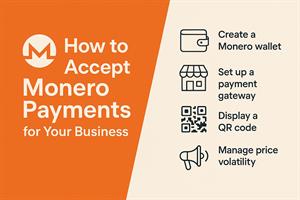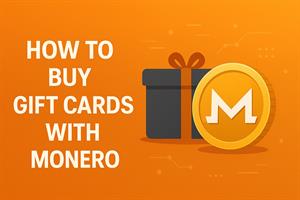Monero (XMR), known for its focus on privacy and untraceability, is one of the most popular privacy-focused cryptocurrencies.

In this guide, we’ll walk you through the steps on how to accept Monero payments for your business, whether you’re running an online store, a service-based business, or a brick-and-mortar shop.
Why Accept Monero Payments?
- Privacy: Transactions are private by default, protecting customer and merchant details.
- Security: Advanced cryptography secures payments end-to-end.
- Low Fees: Typically lower than cards or legacy processors.
- Borderless: Receive payments globally without FX headaches.
- Growing Adoption: Privacy-conscious customers increasingly prefer XMR.
Steps to Accept Monero Payments
1. Create a Monero Wallet
- Desktop: Monero GUI Wallet
- Mobile: Cake Wallet or Monerujo
- Hardware: Ledger or Trezor for cold storage
After setup you’ll have a unique Monero address to receive payments.
2. Set Up a Payment Gateway
For e-commerce, integrate a gateway so checkouts can display an invoice/QR and track status automatically.
Verified E-Commerce Integrations (Monerica)
These options are listed as verified on Monerica and are commonly used with WooCommerce, Shopify, Magento, OpenCart, and WordPress.
-
Coin Payments — Plugins for Magento, Shopify, WooCommerce, OpenCart, and more.
-
NOWPayments — 300+ cryptos, ~0.5% fee, plugins for major carts (Shopify, WooCommerce, Magento, WHMCS) and payout options.
-
MyCryptoCheckout — WordPress/WooCommerce plugin for direct crypto payments.
-
monerowp — Open-source Monero gateway for WooCommerce (self-custody friendly).
-
Cryptomus — White-label crypto payment gateway with flexible merchant features.
-
MixPay — Supports online and in-person flows with instant exchange options.
Verified Open-Source (Self-Hosted)
-
BTCPay — Self-hosted, open-source crypto payment processor.
3. Generate Payment Addresses & QR Codes
Create unique invoices per order (address + amount + QR). Most gateways automate this; many wallets can generate QR codes if you’re running lean.
4. Display “We Accept Monero” at Checkout
List XMR alongside cards and other methods, and add badges on product/checkout pages so customers know they can pay privately.
5. Manage Price Volatility
- Auto-convert to fiat: Some gateways can settle into bank currency.
- Hold XMR: If you’re long-term bullish, hold with clear treasury rules.
6. Keep Records
Maintain internal logs (order ID, amount, time, status) for accounting/tax. Monero is private, but your books shouldn’t be a mystery.
Best Practices
- Test end-to-end with a small order before launch.
- Educate customers with a short “How to pay with Monero” FAQ.
- Stay compliant with your local tax/regulatory requirements.
Accepting Monero In-Store
- Install a mobile wallet (e.g., Cake Wallet).
- Generate a per-sale QR invoice.
- Confirm receipt in your wallet; ship/hand over goods.
Conclusion
Accepting Monero gives your customers private, borderless checkout. Start with a secure wallet, plug in a verified gateway, and make the option prominent at checkout. See the full directory of vetted tools on Monerica merchant services.
